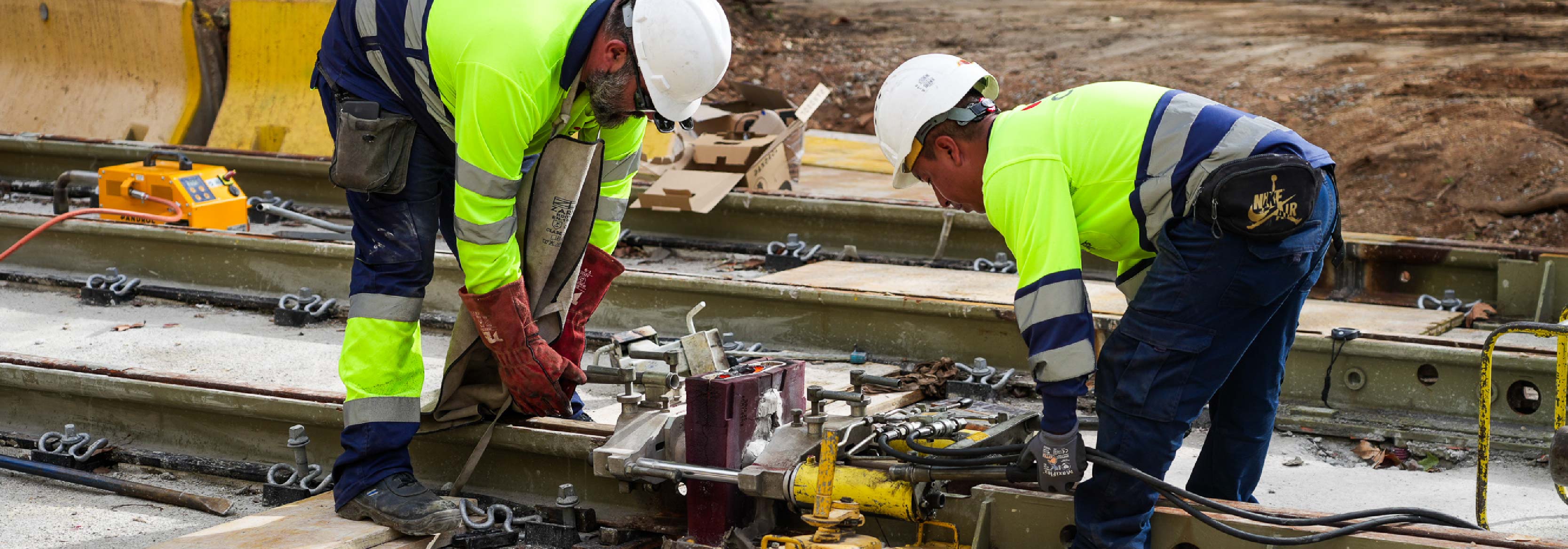The last section of track of phase 1 of the tramway connection works is connected along Diagonal
The last section of track of phase 1 of the tramway connection works is connected along Diagonal
The welding of the lanes at the crossroads of av. Diagonal with Carrer Bailèn completes a large part of the built tramway structure and gives proof of the good pace of work
-
Phase 1 of the infrastructure works for the tram connection are 70% completed
-
The urbanization works are already 85% completed and work is being done to complete the last tasks of connecting services, paving, asphalting and finishing.
Barcelona, November 9.- This Thursday, November 9, the last welding of the rails of phase 1 of the works connecting the trams along Avenida Diagonal in Barcelona between Plaça de Les Glòries and Plaça Mossèn Jacint Verdaguer took place, which allows continuity in most of the structure of the new tracks where the tram will run.
This union of the running lanes has taken place at the confluence of Diagonal with Carrer Bailèn, a few meters from the future Verdaguer stop, starting point of the nearly 2 km of the new route built from Glòries and which will allow connecting through T4 the Trambesòs lines towards the city centre.
With regard to the implementation of the so-called third rail, which undergrounds the catenary and feeds the tram exclusively as it passes continuously and safely, its installation is scheduled to finish in February 2024.
70% of the infrastructure works of phase 1 have been executed
This is a relevant milestone, which gives good proof of the good pace of work to join the two tram networks in the middle of the city, and that currently 70% of its first phase has already been done at tram infrastructure level.
Recently, the new route section built in Glòries, in front of the HUB Barcelona Design Museum, has also been successfully completed, another of the most important milestones of the works and which, with the new stop in the square, is expected to become a great public transport interchange.
The four future stops that will enter service, Glòries, Monumental, Sicília and Verdaguer, already have all the canopies installed.

Urbanization works are now 85% complete
The urbanization works on Diagonal Avenue and Plaça de les Glòries (Canòpia area) are very advanced. The sidewalks on the sea side of Diagonal Avenue, between Carrer de la Marina and Passeig de Sant Joan, have already been completed and all that remains is to carry out the pending service connections (lighting, irrigation, traffic lights and fibre optics). With regard to the sidewalks on the mountain side, work is being done at full capacity and some sections have already been completed. Likewise, the roadways have already been executed where, as of today, it remains to add the last layer of asphalt, the bearing layer, prior to opening to traffic.
The urbanization of Diagonal Avenue, between Carrer de la Marina and Carrer de los Castillejos, is also in full swing and some sections have already been completed. In this area, the agglomerate works must be carried out, both on the side roads and on the central promenade.
In parallel, the new streetlights have already been installed along Diagonal Avenue, as well as the new traffic lights. The works to divert affected services (light, water and gas) are in their final phase.
Finally, in the Plaça de les Glòries area (Canòpia area), paving works are in execution next to Carrer de los Castillejos. Around the DHUB, work continues to progress in a coordinated manner with the structural tasks of the new vestibule.
A work with multiple benefits
As a whole, the new section along Diagonal Avenue will connect Glòries and Verdaguer in 7 minutes, and will link the tram with four metro lines, the L1, L2, L4 and L5, and thirteen TMB bus lines.
This way, it will increase the urban and metropolitan coverage of public transport, bringing up to 19,000 additional passengers to this mode of transport.
In parallel, the city of Barcelona will gain new spaces for citizens by transforming one of its most emblematic avenues. The tram connection represents an opportunity to urbanistically redesign this area, implementing an urban model based on sustainable mobility that prioritizes pedestrians, bicycles and public transport, with the aim of building a healthier, more equitable and sustainable city for everyone.
Related Documents
- Press release 162.84 KB